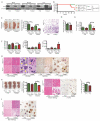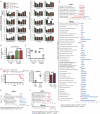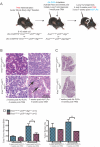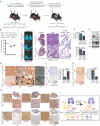Autophagy is required for glucose homeostasis and lung tumor maintenance
- PMID: 24875857
- PMCID: PMC4125614
- DOI: 10.1158/2159-8290.CD-14-0363
Autophagy is required for glucose homeostasis and lung tumor maintenance
Abstract
Macroautophagy (autophagy hereafter) recycles intracellular components to sustain mitochondrial metabolism that promotes the growth, stress tolerance, and malignancy of lung cancers, suggesting that autophagy inhibition may have antitumor activity. To assess the functional significance of autophagy in both normal and tumor tissue, we conditionally deleted the essential autophagy gene, autophagy related 7 (Atg7), throughout adult mice. Here, we report that systemic ATG7 ablation caused susceptibility to infection and neurodegeneration that limited survival to 2 to 3 months. Moreover, upon fasting, autophagy-deficient mice suffered fatal hypoglycemia. Prior autophagy ablation did not alter the efficiency of non-small cell lung cancer (NSCLC) initiation by activation of oncogenic Kras(G12D) and deletion of the Trp53 tumor suppressor. Acute autophagy ablation in mice with preexisting NSCLC, however, blocked tumor growth, promoted tumor cell death, and generated more benign disease (oncocytomas). This antitumor activity occurred before destruction of normal tissues, suggesting that acute autophagy inhibition may be therapeutically beneficial in cancer.
Significance: We systemically ablated cellular self-cannibalization by autophagy in adult mice and determined that it is dispensable for short-term survival, but required to prevent fatal hypoglycemia and cachexia during fasting, delineating a new role for autophagy in metabolism. Importantly, acute, systemic autophagy ablation was selectively destructive to established tumors compared with normal tissues, thereby providing the preclinical evidence that strategies to inhibit autophagy may be therapeutically advantageous for RAS-driven cancers.
©2014 American Association for Cancer Research.
Figures






Comment in
-
Mouse models address key concerns regarding autophagy inhibition in cancer therapy.Cancer Discov. 2014 Aug;4(8):873-5. doi: 10.1158/2159-8290.CD-14-0618. Cancer Discov. 2014. PMID: 25092744 Free PMC article.
References
-
- Mizushima N, Komatsu M. Autophagy: renovation of cells and tissues. Cell. 2011;147:728–41. - PubMed
-
- Kuma A, Hatano M, Matsui M, Yamamoto A, Nakaya H, Yoshimori T, et al. The role of autophagy during the early neonatal starvation period. Nature. 2004;432:1032–6. - PubMed
-
- Hara T, Nakamura K, Matsui M, Yamamoto A, Nakahara Y, Suzuki-Migishima R, et al. Suppression of basal autophagy in neural cells causes neurodegenerative disease in mice. Nature. 2006;441:885–9. - PubMed
Publication types
MeSH terms
Substances
Grants and funding
LinkOut - more resources
Full Text Sources
Other Literature Sources
Medical
Molecular Biology Databases
Research Materials
Miscellaneous

